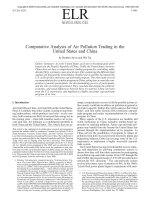Advanced Modelling in Finance using Excel and VBA pot
Bạn đang xem bản rút gọn của tài liệu. Xem và tải ngay bản đầy đủ của tài liệu tại đây (1.4 MB, 278 trang )
Advanced Modelling in Finance
using Excel and VBA
Wiley Finance Series
Operational Risk: Measurement and Modelling
Jack King
Advance Credit Risk Analysis: Financial Approaches and Mathematical Models to Assess, Price and
Manage Credit Risk
Didier Cossin and Hugues Pirotte
Dictionary of Financial Engineering
John F. Marshall
Pricing Financial Derivatives: The Finite Difference Method
Domingo A Tavella and Curt Randall
Interest Rate Modelling
Jessica James and Nick Webber
Handbook of Hybrid Instruments: Convertible Bonds, Preferred Shares, Lyons, ELKS, DECS and
Other Mandatory Convertible Notes
Izzy Nelken (ed)
Options on Foreign Exchange, Revised Edition
David F DeRosa
The Handbook of Equity Derivatives, Revised Edition
Jack Francis, William Toy and J Gregg Whittaker
Volatility and Correlation in the Pricing of Equity, FX and Interest-Rate Options
Riccardo Rebonato
Risk Management and Analysis vol. 1: Measuring and Modelling Financial Risk
Carol Alexander (ed)
Risk Management and Analysis vol. 2: New Markets and Products
Carol Alexander (ed)
Implementing Value at Risk
Philip Best
Credit Derivatives: A Guide to Instruments and Applications
Janet Tavakoli
Implementing Derivatives Models
Les Clewlow and Chris Strickland
Interest-Rate Option Models: Understanding, Analysing and Using Models for Exotic Interest-Rate
Options (second edition)
Riccardo Rebonato
Advanced Modelling in Finance
using Excel and VBA
Mary Jackson
and
Mike Staunton
JOHN WILEY & SONS, LTD
Chichester
ž
New York
ž
Weinheim
ž
Brisbane
ž
Singapore
ž
Toronto
Copyright 2001 by John Wiley & Sons, Ltd,
Baffins Lane, Chichester,
West Sussex PO19 1UD, England
National 01243 779777
International (C44) 1243 779777
e-mail (for orders and customer service enquiries):
Visit our Home Page on
or
All Rights Reserved. No part of this publication may be reproduced, stored in a retrieval
system, or transmitted, in any form or by any means, electronic, mechanical, photocopying,
recording, scanning or otherwise, except under the terms of the Copyright, Designs and Patents Act
1988 or under the terms of a licence issued by the Copyright Licensing Agency, 90 Tottenham Court
Road, London W1P 9HE, UK, without the permission in writing of the publisher.
Other Wiley Editorial Offices
John Wiley & Sons, Inc., 605 Third Avenue,
New York, NY 10158-0012, USA
Wiley-VCH Verlag GmbH, Pappelallee 3,
D-69469 Weinheim, Germany
John Wiley & Sons Australia Ltd, 42 McDougall Street, Milton,
Queensland 4064, Australia
John Wiley & Sons (Asia) Pte Ltd, 2 Clementi Loop #02-01,
Jin Xing Distripark, Singapore 129809
John Wiley & Sons Canada Ltd, 6045 Freemont Blvd,
Mississauga, ONT, L5R 4J3, Canada
British Library Cataloguing in Publication Data
A catalogue record for this book is available from the British Library
ISBN 0 471 49922 6
Typeset in 10/12pt Times by Laserwords Private Limited, Chennai, India
Printed and bound in Great Britain by Bookcraft (Bath) Ltd, Midsomer–Norton
This book is printed on acid-free paper responsibly manufactured from sustainable forestry,
in which at least two trees are planted for each one used for paper production.
Contents
Preface xi
Acknowledgements xii
1 Introduction 1
1.1 Finance insights 1
1.2 Asset price assumptions 2
1.3 Mathematical and statistical problems 2
1.4 Numerical methods 2
1.5 Excel solutions 3
1.6 Topics covered 3
1.7 Related Excel workbooks 5
1.8 Comments and suggestions 5
Part One Advanced Modelling in Excel 7
2 Advanced Excel functions and procedures 9
2.1 Accessing functions in Excel 9
2.2 Mathematical functions 10
2.3 Statistical functions 12
2.3.1 Using the frequency function 12
2.3.2 Using the quartile function 14
2.3.3 Using Excel’s normal functions 15
2.4 Lookup functions 16
2.5 Other functions 18
2.6 Auditing tools 19
2.7 Data Tables 20
2.7.1 Setting up Data Tables with one input 20
2.7.2 Setting up Data Tables with two inputs 22
2.8 XY charts 23
2.9 Access to Data Analysis and Solver 26
2.10 Using range names 27
2.11 Regression 28
2.12 Goal Seek 31
vi Contents
2.13 Matrix algebra and related functions 33
2.13.1 Introduction to matrices 33
2.13.2 Transposing a matrix 33
2.13.3 Adding matrices 34
2.13.4 Multiplying matrices 34
2.13.5 Matrix inversion 35
2.13.6 Solving systems of simultaneous linear equations 36
2.13.7 Summary of Excel’s matrix functions 37
Summary 37
3 Introduction to VBA 39
3.1 Advantages of mastering VBA 39
3.2 Object-oriented aspects of VBA 40
3.3 Starting to write VBA macros 42
3.3.1 Some simple examples of VBA subroutines 42
3.3.2 MsgBox for interaction 43
3.3.3 The writing environment 44
3.3.4 Entering code and executing macros 44
3.3.5 Recording keystrokes and editing code 45
3.4 Elements of programming 47
3.4.1 Variables and data types 48
3.4.2 VBA array variables 48
3.4.3 Control structures 50
3.4.4 Control of repeating procedures 51
3.4.5 Using Excel functions and VBA functions in code 52
3.4.6 General points on programming 53
3.5 Communicating between macros and the spreadsheet 53
3.6 Subroutine examples 56
3.6.1 Charts 56
3.6.2 Normal probability plot 59
3.6.3 Generating the efficient frontier with Solver 61
Summary 65
References 65
Appendix 3A The Visual Basic Editor 65
Stepping through a macro and using other
debug tools 68
Appendix 3B Recording keystrokes in ‘relative references’ mode 69
4 Writing VBA user-defined functions 73
4.1 A simple sales commission function 73
4.2 Creating Commission(Sales) in the spreadsheet 74
4.3 Two functions with multiple inputs for valuing options 75
4.4 Manipulating arrays in VBA 78
4.5 Expected value and variance functions with array inputs 79
4.6 Portfolio variance function with array inputs 81
4.7 Functions with array output 84
4.8 Using Excel and VBA functions in user-defined functions 85
Contents vii
4.8.1 Using VBA functions in user-defined functions 85
4.8.2 Add-ins 86
4.9 Pros and cons of developing VBA functions 86
Summary 87
Appendix 4A Functions illustrating array handling 88
Appendix 4B Binomial tree option valuation functions 89
Exercises on writing functions 94
Solution notes for exercises on functions 95
Part Two Equities 99
5 Introduction to equities 101
6 Portfolio optimisation 103
6.1 Portfolio mean and variance 103
6.2 Risk–return representation of portfolios 105
6.3 Using Solver to find efficient points 106
6.4 Generating the efficient frontier (Huang and Litzenberger’s
approach) 109
6.5 Constrained frontier portfolios 111
6.6 Combining risk-free and risky assets 113
6.7 Problem One–combining a risk-free asset with a risky asset 114
6.8 Problem Two–combining two risky assets 115
6.9 Problem Three–combining a risk-free asset with a risky portfolio 117
6.10 User-defined functions in Module1 119
6.11 Functions for the three generic portfolio problems in Module1 120
6.12 Macros in ModuleM 121
Summary 123
References 123
7 Asset pricing 125
7.1 The single-index model 125
7.2 Estimating beta coefficients 126
7.3 The capital asset pricing model 129
7.4 Variance–covariance matrices 130
7.5 Value-at-Risk 131
7.6 Horizon wealth 134
7.7 Moments of related distributions such as normal and lognormal 136
7.8 User-defined functions in Module1 136
Summary 138
References 138
8 Performance measurement and attribution 139
8.1 Conventional performance measurement 140
8.2 Active–passive management 141
8.3 Introduction to style analysis 144
viii Contents
8.4 Simple style analysis 145
8.5 Rolling-period style analysis 146
8.6 Confidence intervals for style weights 148
8.7 User-defined functions in Module1 151
8.8 Macros in ModuleM 151
Summary 152
References 153
Part Three Options on Equities 155
9 Introduction to options on equities 157
9.1 The genesis of the Black–Scholes formula 158
9.2 The Black–Scholes formula 158
9.3 Hedge portfolios 159
9.4 Risk-neutral valuation 161
9.5 A simple one-step binomial tree with risk-neutral valuation 162
9.6 Put–call parity 163
9.7 Dividends 163
9.8 American features 164
9.9 Numerical methods 164
9.10 Volatility and non-normal share returns 165
Summary 165
References 166
10 Binomial trees 167
10.1 Introduction to binomial trees 167
10.2 A simplified binomial tree 168
10.3 The Jarrow and Rudd binomial tree 170
10.4 The Cox, Ross and Rubinstein tree 173
10.5 Binomial approximations and Black–Scholes formula 175
10.6 Convergence of CRR binomial trees 176
10.7 The Leisen and Reimer tree 177
10.8 Comparison of CRR and LR trees 178
10.9 American options and the CRR American tree 180
10.10 User-defined functions in Module0 and Module1 182
Summary 183
References 184
11 The Black–Scholes formula 185
11.1 The Black–Scholes formula 185
11.2 Black–Scholes formula in the spreadsheet 186
11.3 Options on currencies and commodities 187
11.4 Calculating the option’s ‘greek’ parameters 189
11.5 Hedge portfolios 190
11.6 Formal derivation of the Black–Scholes formula 192
Contents ix
11.7 User-defined functions in Module1 194
Summary 195
References 196
12 Other numerical methods for European options 197
12.1 Introduction to Monte Carlo simulation 197
12.2 Simulation with antithetic variables 199
12.3 Simulation with quasi-random sampling 200
12.4 Comparing simulation methods 202
12.5 Calculating greeks in Monte Carlo simulation 203
12.6 Numerical integration 203
12.7 User-defined functions in Module1 205
Summary 207
References 207
13 Non-normal distributions and implied volatility 209
13.1 Black–Scholes using alternative distributional assumptions 209
13.2 Implied volatility 211
13.3 Adapting for skewness and kurtosis 212
13.4 The volatility smile 215
13.5 User-defined functions in Module1 217
Summary 219
References 220
Part Four Options on Bonds 221
14 Introduction to valuing options on bonds 223
14.1 The term structure of interest rates 224
14.2 Cash flows for coupon bonds and yield to maturity 225
14.3 Binomial trees 226
14.4 Black’s bond option valuation formula 227
14.5 Duration and convexity 228
14.6 Notation 230
Summary 230
References 230
15 Interest rate models 231
15.1 Vasicek’s term structure model 231
15.2 Valuing European options on zero-coupon bonds, Vasicek’s model 234
15.3 Valuing European options on coupon bonds, Vasicek’s model 235
15.4 CIR term structure model 236
15.5 Valuing European options on zero-coupon bonds, CIR model 237
15.6 Valuing European options on coupon bonds, CIR model 238
15.7 User-defined functions in Module1 239
Summary 240
References 241
x Contents
16 Matching the term structure 243
16.1 Trees with lognormally distributed interest rates 243
16.2 Trees with normal interest rates 246
16.3 The Black, Derman and Toy tree 247
16.4 Valuing bond options using BDT trees 248
16.5 User-defined functions in Module1 250
Summary 252
References 252
Appendix Other VBA functions 253
Forecasting 253
ARIMA modelling 254
Splines 256
Eigenvalues and eigenvectors 257
References 258
Index 259
Preface
When asked why they tackled Mount Everest, climbers typically reply “Because it was
there”. Our motivation for writing Advanced Modelling in Finance is for exactly the
opposite reason. There were then, and still are now, almost no books that give due
prominence to and explanation of the use of VBA functions within Excel. There is an
almost similar lack of books that capture the true vibrant spirit of numerical methods
in finance.
It is no longer true that spreadsheets such as Excel are inadequate tools in highly tech-
nical and numerically demanding areas such as the valuation of financial derivatives. With
efficient code and VBA functions, calculations that were once the preserve of dedicated
packages and languages can now be done on a modern PC in Excel within seconds, if
not fractions of a second. By employing Excel and VBA, our purpose is to try to bring
clarity to an area that was previously covered with black boxes.
What started as an attempt to push back the boundaries of Excel through macros turned
into a full-scale expedition into the VBA language within Excel and then developed from
equities, through options and finally to cover bonds. Along the way we learned scores of
new Excel skills and a much greater understanding of the numerical methods implemented
across finance.
The genesis of the book came from material developed for the ‘Computer-Based Finan-
cial Modelling’ elective on the MBA degree at London Business School. The part on
equities formed the basis for an executive course on ‘Equity Portfolio Management’ run
annually by the International Centre for Money and Banking in Geneva. The parts on
options and bonds comprise a course in ‘Numerical Methods’ on the MSc in Mathemat-
ical Trading and Finance at City University Business School. The book is within the reach
of both students at the postgraduate level and those in the latter undergraduate years.
There are no prerequisites for readers apart from a willingness to adopt a pro-active
stance when using the book–namely by taking advantage of the inherent ‘what-if’ quality
of the spreadsheets and by looking at and using the code forming the VBA user-defined
functions. Since we assume for the most part that asset returns are lognormal and therefore
use binomial trees as a central numerical method, our explanations can be based on
familiar results from probability and statistics. Comprehension is helped by the use of a
common notation throughout, and transparency by the availability of complete solutions
in both Excel and VBA forms.
Acknowledgements
Our main debt is to the individuals from the academic and practitioner communities in
finance who first developed the theory and then the numerical methods that form the
material for this book. In the words of Sir Isaac Newton “If I have seen further it is by
standing on the shoulders of giants”.
We would also like to thank our colleagues at both London Business School and City
University Business School, in particular Elroy Dimson, John Hatgioannides, Paul Marsh
and Kiriakos Vlahos.
We would like to thank Sam Whittaker at Wiley for her enthusiasm, encouragement
and much needed patience, invaluable qualities for an editor.
Last but not least, we are grateful for the patience of family and friends who have
occasionally chivvied us about the book’s somewhat lengthy gestation period.
1
Introduction
We hope that our text, Advanced Modelling in Finance, is conclusive proof that a wide
range of models can now be successfully implemented using spreadsheets. The models
range across the complete spectrum of finance including equities, equity options and bond
options spanning developments from the early fifties to the late nineties. The models are
implemented in Excel spreadsheets, complemented with functions written using the VBA
language within Excel. The resulting user-defined functions provide a portable library of
programs with more than sufficient speed and accuracy.
Advanced Modelling in Finance should be viewed as a complement (or dare we say,
an antidote) to traditional textbooks in the area. It contains relatively few derivations,
allowing us to cover a broader range of models and methods, with particular emphasis
on more recent advances.
The major theoretical developments in finance such as portfolio theory in the 1950s,
the capital asset pricing model in the 1960s and the Black–Scholes formula in the 1970s
brought with them analytic solutions that are now straightforward to calculate. The subse-
quent decades have seen a growing body of developments in numerical methods. With an
intelligent choice of parameters, binomial trees have assumed a central role in the more
numerically-intensive calculations now required to value equity and bond options. The
centre of gravity in finance now concerns the search for more efficient ways of performing
such calculations rather than the theories from yesteryear.
The breadth of the coverage across finance and the sophistication needed for some
of the more advanced models are testament to the ability of Excel, the built-in functions
contained in Excel and the real programming environment that VBA provides. This allows
us to highlight the commonality of assumptions (lognormality), mathematical problems
(expectation) and numerical methods (binomial trees) throughout finance as a whole.
Without exception, we have tried to ensure a consistent and simple notation throughout
the book to reinforce this commonality and to improve clarity of exposition.
Our objective in writing a book that covers the broad range of subjects in finance
has proved to be both a challenge and an opportunity. The opportunity has provided
us with the chance to overview finance as a whole and, in so doing, to make impor-
tant connections and bring out commonalities in asset price assumptions, mathemat-
ical problems, numerical methods and Excel solutions. In the following sections we
summarise a few of these unifying insights that apply to equities, options and bonds
with regard to finance, mathematical topics, numerical methods and Excel features. This
is followed by a more detailed summary of the main topics covered in each chapter of
the book.
1.1 FINANCE INSIGHTS
The genesis of modern finance as a subject separate from economics started with
Markowitz’s development of portfolio theory in 1952. Markowitz used utility theory to
model the preferences of individual investors and to develop a mean–variance approach
2 Advanced Modelling in Finance
to examining the trade-off between return (as measured by an asset’s mean return) and
risk (measured by an asset’s variance of return). This subsequently led to the development
by Sharpe, Lintner and Treynor of the capital asset pricing model (CAPM), an equilibrium
model describing expected returns on equities. The CAPM introduced beta as a measure
of diversifiable risk, arguing that the creation of portfolios served to minimise the specific
risk element of total risk (variance).
The next great theoretical development was the equity option pricing formula of Black
and Scholes, which rested on the ability to create a (riskless) hedge portfolio. Contempora-
neously, Merton extended the Black–Scholes formula to allow for continuous dividends
and thus also options on commodities and currencies. The derivation of the original
formula required the solving of the diffusion (or heat) equation familiar from physics, but
was subsequently encompassed by the broader risk-neutral approach to the valuation of
derivatives.
1.2 ASSET PRICE ASSUMPTIONS
Although portfolio theory was derived through individual preferences, it could also have
been obtained by making assumptions about the distribution of asset price returns. The
standard assumption is that equity returns follow a lognormal distribution–equivalently we
can say that equity log returns follow a normal distribution. More recently, practitioners
have examined the effect of departures from strict normality (as measured by skewness
and kurtosis) and have also proposed different distributions (for example, the reciprocal
gamma distribution).
Although bonds have characteristics that are different from equities, the starting point
for bond option valuation is the short interest rate. This is frequently assumed to follow
the lognormal or normal distribution. The result is that familiar results grounded in these
probability distributions can be applied throughout finance.
1.3 MATHEMATICAL AND STATISTICAL PROBLEMS
Within the equities part, the mathematical problems concern optimisation. The optimi-
sation can also include additional constraints, exemplified by Sharpe’s development of
returns-based style analysis. Beta is estimated as the slope coefficient in a linear regression.
Options are valued in the risk-neutral framework as statistical expectations. The normal
distribution of log equity prices can be approximated by an equivalent discrete bino-
mial distribution. This binomial distribution provides the framework for calculating the
expected option value.
1.4 NUMERICAL METHODS
In the context of portfolio optimisation, the optimisation involves portfolio variance, and
the numerical method needed for optimisation is quadratic programming. Style analysis
also uses quadratic programming, the quantity to be minimised being the error variance.
Although not usually thought of as optimisation, linear regression chooses slope coef-
ficients to minimise residual error. Here optimisation is of a different kind, regression
analysis, which provides analytical formulas to calculate the beta coefficients.
Turning to option valuation, the binomial tree provides the structure within which
the risk-neutral expectation can be calculated. We highlight the importance of parameter
Introduction 3
choice by examining the convergence properties of three different binomial trees. Such
trees also allow the valuation of American options, where the option can be exercised at
any date prior to maturity.
With European options, techniques such as Monte Carlo simulation and numerical
integration are also used. Numerical search methods, in particular the Newton–Raphson
approach, ensure that volatilities implied by option prices in the market can be estimated.
1.5 EXCEL SOLUTIONS
The spreadsheets demonstrate how Excel can be used as a prototype for building models.
Within the individual spreadsheets, all the formulas in the cells can easily be examined
and we have endeavoured to incorporate all intermediate calculations in cells of their
own. The spreadsheets also allow the hallmark ability to ‘what-if’ by changing parameter
values in cells.
The implementation of all the models and methods occurs twice: once in the spread-
sheets and once in the VBA functions. This dual approach serves as an important check
on the accuracy of the numerical calculations.
Some of the VBA procedures are macros, normally seen by others as the main purpose
of VBA in Excel. However, the majority of the procedures we implement are user-defined
functions. We demonstrate how easily these functions can be written in VBA and how
they can incorporate Excel functions, including the powerful matrix functions.
The Goal Seek and Solver commands within Excel are used in the optimisation tasks.
We show how these commands can be automated using VBA user-defined functions and
macros. Another under-used aspect of Excel involves the application of array functions
(invoked by the CtrlCShiftCEnter keystroke combination) and we implement these in
user-defined functions. To improve efficiency, our binomial trees in user-defined functions
use one-dimensional arrays (vectors) rather than two-dimensional arrays (matrices).
1.6 TOPICS COVERED
There are four parts in the book, the first part illustrating the advanced modelling features
in Excel followed by three parts with applications in finance. The three parts on applica-
tions cover equities, options on equities and options on bonds.
Chapter 2 emphasises the advanced Excel functions and techniques that we use in the
remainder of the book. We pay particular attention to the array functions within Excel
and provide a short section detailing the mathematics underlying matrix manipulation.
Chapter 3 introduces the VBA programming environment and illustrates a step-by-step
approach to the writing of VBA subroutines (macros). The examples chosen demonstrate
how macros can be used to automate and repeat tasks in Excel.
Chapter 4 moves on to VBA user-defined functions, which have a crucial role
throughout the applications in finance. We emphasise how to deal with both scalar
and array variables–as input variables to VBA functions, their use in calculations and
finally as output variables. Again, we use a step-by-step approach for a number of
examples. In particular, we write user-defined functions to value both European options
(the Black–Scholes formula) and American options (binomial trees).
Chapter 5 introduces the first application part, that dealing with equities.
Chapter 6 covers portfolio optimisation, using both Solver and analytic solutions. As
will become the norm in the remaining chapters, Solver is used both in the spreadsheet
4 Advanced Modelling in Finance
and automated in a VBA macro. By using the array functions in Excel and VBA, we detail
how the points on the efficient frontier can be generated. The development of portfolio
theory is divided into three generic problems, which recur in subsequent chapters.
Chapter 7 looks at (equity) asset pricing, starting with the single-index model and
the capital asset pricing model (CAPM) and concluding with Value-at-Risk (VaR). This
introduces the assumption that asset log returns follow a normal distribution, another
recurrent theme.
Chapter 8 covers performance measurement, again ranging from single-parameter
measures used in the very earliest days to multi-index models (such as style analysis) that
represent current best practice. We show, for the first time in a textbook, how confidence
intervals can be determined for the asset weights from style analysis.
Chapter 9 introduces the second application part, that dealing with options on equities.
Building on the normal distribution assumed for equity log returns, we detail the creation
of the hedge portfolio that is the key insight behind the Black–Scholes option valuation
formula. The subsequent interpretation of the option value as the discounted expected
value of the option payoff in a risk-neutral world is also introduced.
Chapter 10 looks at binomial trees, which can be viewed as a discrete approxima-
tion to the continuous normal distribution assumed for log equity prices. In practice,
binomial trees form the backbone of numerical methods for option valuation since they
can cope with early exercise and hence the valuation of American options. We illustrate
three different parameter choices for binomial trees, including the little-known Leisen and
Reimer tree that has vastly superior convergence and accuracy properties compared to the
standard parameter choices. We use a nine-step tree in our spreadsheet examples, but the
user-defined functions can cope with any number of steps.
Chapter 11 returns to the Black–Scholes formula and shows both its adaptability
(allowing options on assets such as currencies and commodities to be valued) and its
dependence on the asset price assumptions.
Chapter 12 covers two alternative ways of calculating the statistical expectation that
lies behind the Black–Scholes formula for European options. These are Monte Carlo
simulation and numerical integration. Although these perform less well for the simple
options we consider, each of these methods has a valuable role in the valuation of more
complicated options.
Chapter 13 moves away from the assumption of strict normality of asset log returns and
shows how such deviation (typically through differing skewness and kurtosis parameters)
leads to the so-called volatility smile seen in the market prices of options. Efficient
methods for finding the implied volatility inherent in European option prices are described.
Chapter 14 introduces the third application part, that dealing with options on bonds.
While bond prices have characteristics that are different from equity prices, there is a
lot of commonality in the mathematical problems and numerical methods used to value
options. We define the term structure based on a series of zero-coupon bond prices, and
show how the short-term interest rate can be modelled in a binomial tree as a means of
valuing zero-coupon bond cash flows.
Chapter 15 covers two models for interest rates, those of Vasicek and Cox, and Ingersoll
and Ross. We detail analytic solutions for zero-coupon bond prices and options on zero-
coupon bonds together with an iterative approach to the valuation of options on coupon
bonds.
Chapter 16 shows how the short rate can be modelled in a binomial tree in order
to match a given term structure of zero-coupon bond prices. We build the popular
Introduction 5
Black–Derman–Toy interest rate tree (both in the spreadsheet and in user-defined func-
tions) and show how it can be used to value both European and American options on
zero-coupon bonds.
The final Appendix is a Pandora’s box of other user-defined functions, that are less rele-
vant to the chosen applications in finance. Nevertheless they constitute a useful toolbox,
including as they do functions for ARIMA modelling, splines, eigenvalues and other
calculation procedures.
1.7 RELATED EXCEL WORKBOOKS
Part I which concentrates on Excel functions and procedures and understanding VBA has
three related workbooks, AMFEXCEL, VBSUB and VBFNS which accompany Chap-
ters 2, 3 and 4 respectively.
Part II on equities has three related workbooks, EQUITY1, EQUITY2 and EQUITY3
which accompany Chapters 6, 7 and 8 respectively.
Part III on options on equities has four files, OPTION1, OPTION2, OPTION3 and
OPTION4 which accompany Chapters 10, 11, 12 and 13 respectively.
Part IV on bonds has two related workbooks, BOND1 and BOND2 which accompany
Chapters 14, 15 and 16 as indicated in the text.
The Appendix has one workbook, OTHERFNS.
1.8 COMMENTS AND SUGGESTIONS
Having spent so much time developing the material and writing this book, we would very
much appreciate any comments, suggestions and, dare we say, possible corrections and
improvements. Please email or find your way to www.london.edu/
ifa/services/services.html or www.business.city.ac.uk/irmi/mstaunton.html.
Part One
Advanced Modelling in Excel
2
Advanced Excel Functions and Procedures
The purpose of this chapter is to review certain Excel functions and procedures used
in the text. These include mathematical, statistical and lookup functions from Excel’s
extensive range of functions, as well as much-used procedures such as setting up Data
Tables and displaying results in XY charts. Also included are methods of summarising
data sets, conducting regression analyses, and accessing Excel’s Goal Seek and Solver.
The objective is to clarify and ensure that this material causes the reader no difficulty.
The advanced Excel user may wish to skim the content or use the chapter for further
reference as and when required. To make the various topics more entertaining and more
interactive, a workbook AMFEXCEL.xls includes the examples discussed in the text and
allows the reader to check his or her proficiency.
2.1 ACCESSING FUNCTIONS IN EXCEL
Excel provides many worksheet functions, which are essentially calculation routines that
have been coded up. They are useful for simplifying calculations performed in the spread-
sheet, and also for combining into VBA macros and user-defined functions (topics covered
in Chapters 3 and 4).
The Paste Function button (labelled fx) on the standard toolbar gives access to them. (It
was previously known as the function wizard.) As Figure 2.1 shows, functions are grouped
into different categories: mathematical, statistical, logical, lookup and reference, etc.
Figure 2.1 Paste Function dialog box showing the COMBIN function in the Math category
10 Advanced Modelling in Finance
Here the Math & Trig function COMBIN has been selected, which produces a brief
description of the function’s inputs and outputs. For a fuller description, press the Help
button (labelled ?).
On clicking OK, the Formula palette appears providing slots for entering the appropriate
inputs, as in Figure 2.2. The required inputs can be keyed into the slots (as here) or
‘selected’ by referencing cells in the spreadsheet (by clicking the buttons to collapse the
Formula palette). Note that the palette can be dragged away from its standard position.
Clicking the OK button on the palette or the tick on the Edit line enters the formula in
the spreadsheet.
Figure 2.2 Building the COMBIN function in the Formula palette
As well as the Formula palette with inputs for function COMBIN, Figure 2.2 shows the
construction of the cell formula on the Edit line, with the Paste Function button depressed
(in action). Notice also the Paste Name button (labelled Dab) which facilitates pasting of
named cells into the formula. (Attaching names to ranges and referencing cell ranges by
names is reviewed in section 2.10.)
As well as all Excel functions, the Paste Function button also provides access to the
user-defined category of functions which are described in Chapter 4.
Having discussed how to access the functions, in the following sections we describe
some specific mathematical and statistical functions.
2.2 MATHEMATICAL FUNCTIONS
Within the Math & Trig category, we make use of the EXP(x), LN(x), SQRT(x), RAND(),
FACT(x) and COMBIN(number, number
chosen) functions.
EXP(x) returns values of the exponential function, exp(x)ore
x
. For example:
ž EXP(1) returns value of e (2.7183 when formatted to four decimal places)
ž EXP(2) returns value of e
2
(7.3891 to four decimal places)
ž EXP(1) returns value of 1/eore
1
(0.36788 to five decimal places)









